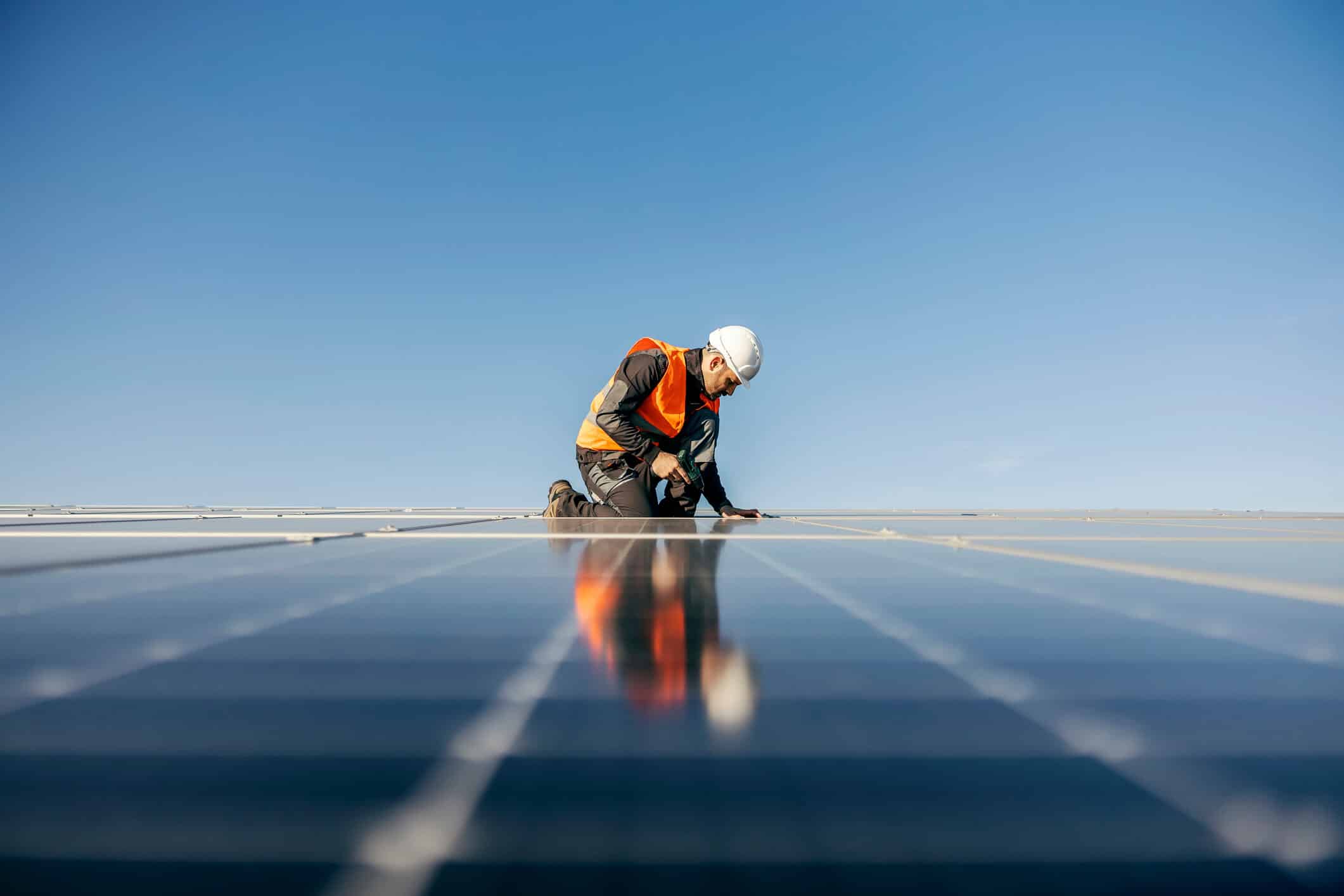POSTED
September 15, 2023
56 Common Solar Energy Investing Terms Defined
There are a lot of unfamiliar terms in the solar energy industry. Many savvy investors want to invest in utility-grade solar but aren’t familiar with solar investing terms unique to the niche. Our goal is to make investing in solar energy approachable for you! This blog post will make solar investing more attainable by covering […]

There are a lot of unfamiliar terms in the solar energy industry. Many savvy investors want to invest in utility-grade solar but aren’t familiar with solar investing terms unique to the niche.
Our goal is to make investing in solar energy approachable for you! This blog post will make solar investing more attainable by covering solar investing terms and definitions common to the industry.
general solar investing terms
Solar investing
Investing in companies that produce energy or are related to solar energy technology and products.
Utility-scale solar
Any solar project connecting to the utility transmission infrastructure to sell power into the wholesale energy market. These projects are commonly above 1 megawatt or more.
Solar farm
A large area where solar panels are installed to create electricity for general use on the grid.
Community solar
A solar project that is owned by the energy users directly or through Community Solar Subscription Agreements benefiting those different groups of users locally.
Microgrid
An electricity network that is attached to a large network but functions independently for a locale.
Commercial & Industrial (C&I) solar
Solar that powers commercial and industrial facilities.
Residential solar
Solar panels that power one house.
Renewable energy
An energy source that is not depleted by usage.
Fossil fuels
Natural fuels formed from the remains of plants and animals.
Solar development terms
Capacity Analysis
An engineering evaluation of a substation and the associated transmission system, modeling the capacity (or lack of capacity) to connect new energy at that location.
Cluster Study
An interconnection and system impact study undertaken by a utility on a group of solar projects.
Solar Land Development
Preparing and installing solar on a piece of land.
Land Control
The legal right, by way of a lease or purchase (usually by an option contract), to develop and manage a solar farm on a property or group of properties.
Fatal Flaw Analysis
The process of a third party examining a solar project’s feasibility to ensure there are no “fatal flaws” preventing it from being permitted, constructed, or shut down once operating.
Interconnection Queue Position
A Solar project’s position in the line-up of requests for interconnection.
Solar development site
The property where a solar farm is developed.
Site analysis, selection, and acquisition
The process of choosing and purchasing or leasing property for a solar farm.
Environmental Impact Report (EIR)
Studies taken to inform the public of the impact of a solar project on the environment.
Habitat and Archaeological Surveys
Examining the different types of life that exist, and the history of human habitation the area of a potential solar project.
Conditional Use Permit
A permit issued to a landowner or developer by a city or county for a particular use of land that may not be generally allowed within regular zoning laws.
Notice To Proceed (NTP)
The final approval from all project-level authorities, including Federal, State County and Municipal, or other entities so that construction of a solar farm may proceed.
System Impact Study
An engineering study of a solar project’s modeled theoretical impact on the grid and the transmission infrastructure as a result of interconnecting.
Grid Parity
When the cost of alternative energy is less than or equal to the cost of fossil-fueled energy.
Net Metering
A system allowing solar power to be used by private parties on site to decrease the cost of electricity they would normally buy from the utility. As solar energy is produced by a private source, it is used on-site. If excess power is produced, the meter can run “backwards” effectively selling power back to the utility at a wholesale rate. When the power is not being produced—say at night— the private entity buys power from the utility at a retail rate as usual. These transactions net over time and the difference is calculated monthly.
Utility Deposits
Money paid to a utility company to secure an interconnection queue position for a solar project that will be refunded if the project were to fail.
Solar Land Options
Options for property to be used to develop a solar farm.
Commercial Operation Date (COD)
The date that a solar project comes online
Permission To Operate (PTO)
Final approval from a utility company and any other relevant authorities that a solar farm can connect and begin generating electricity.
Solar financing terms
Solar Loan
A loan to finance a solar project.
Solar Lease
Leasing instead of buying a solar system.
Interconnection Agreement (IA)
A contract to connect and use transmission infrastructure between an IPP (Independent Power Producer) and utility company.
Solar Power Purchase Agreement (PPA)
Agreement between an IPP and a utility to sell energy at a set price for a specific period of time. Commonly 15-25 years.
Investment Tax credit (ITC)
Tax Federal credit for residential, commercial, industrial, or utility-scale solar systems. The credit amount varies depending on the specifics of the solar installation.
Production Tax Credit (PTC)
Tax credit that offers a benefit calculated based on each kilowatt-hour (kWh) of electricity produced by solar systems and other eligible technologies.
Domestic Procurement
Acquiring goods and services only from domestic companies.
Energy Community
Communities that have historically relied on fossil fuels as a substantial part of the local economy. These communities may have a coal mine, oil field, natural gas plant, or refinery nearby and are therefore at risk of job loss during the transition to new, renewable energy.
Rate escalation
Increase of price per KW/hr.
Solar fund investment terms
Accredited Investor
Investor worth over $1 million, or with over $200,000 earned in the past two years and projected future earnings.
ESG Investing
Investing based on environmental, social, and governance standards.
SRI Investing
Socially responsible investing, AKA Sustainable Responsible Impact investing.
Impact Investing
Investments made to create social or environmental change.
Minimum Investment
Least investment total required.
Investment Hold Period
Time investment is held and is therefore illiquid.
Capitalization Planning
Planning how an organization or solar project’s operations will be funded.
Return on Investment (ROI)
A simple formula to demonstrate a profit made from investment represented as a percentage: ROI = Net income / Cost of investment x 100.
Rate of Return (ROR)
A formula represented as a percentage of the profit earned on an investment: Rate of Return % = [(Current Value – Initial Value) / Initial Value] x 100.
Internal Rate of Return (IRR)
A calculation commonly used in finance that takes into consideration the initial investment cost followed by annual cash flows discounted over a period of time: Internal Rate of Return (IRR) = (Future Value ÷ Present Value)^(1 ÷ Number of Periods) – 1.
Preferred Return
An annually accumulating interest rate paid to investors before other profits are distributed.
Cap Rate
Examination of a project’s profit over a year expressed as a percentage.
Discount Rate Calculation
A percentage interest rate used to calculate the present value of a solar investment.
Investigation Period
Time researching and conducting due diligence for a solar project, once land is controlled, but before the solar project is operational—usually 6 months to 2 years.
Pre-operation Period
Time after land acquisition before a project begins operating—usually 5-7 years.
Operation Period
Time a project operates, usually 30-40 years.
Waterfall
How profit flows to the different invested parties.
Subscription Agreement
The contract between private investors and an investment vehicle in private equity.
Private Placement Memorandum
Document outlining terms and risks of an investment to attract and inform investors.
Invest directly in solar through Shasta Power
If you’re ready to learn more about how you can invest in the powerful world of renewable energy, we’re here for you. Click here to watch a free webinar from Shasta Power partners Max and John about how you can impact the earth and your own financial future.





